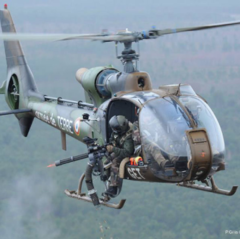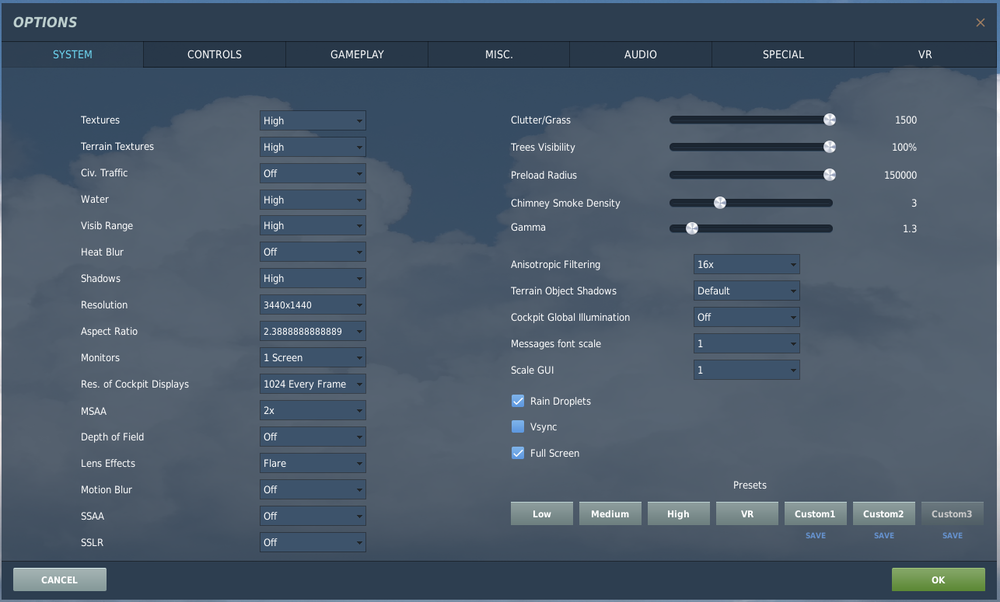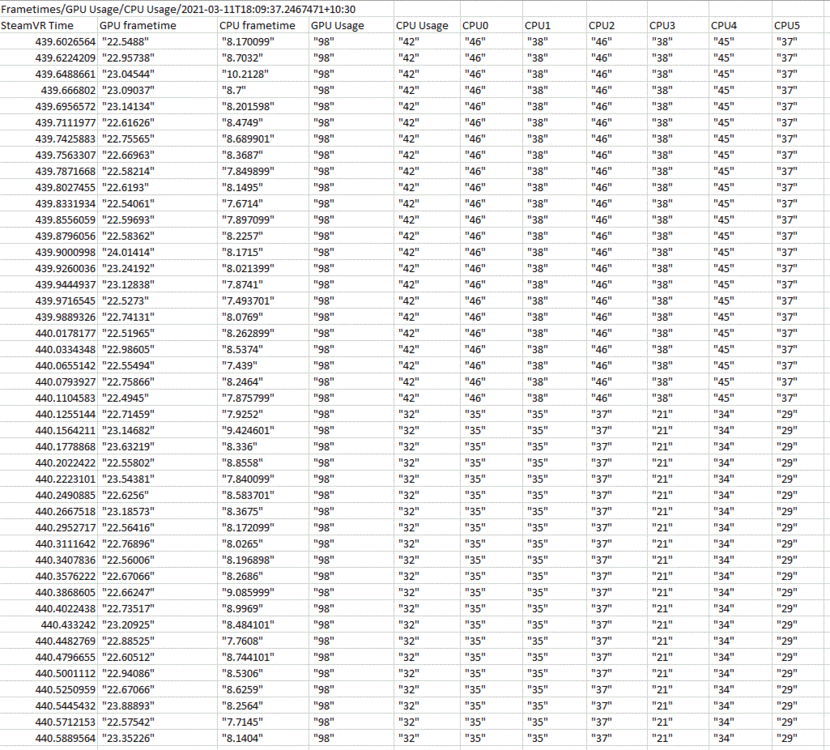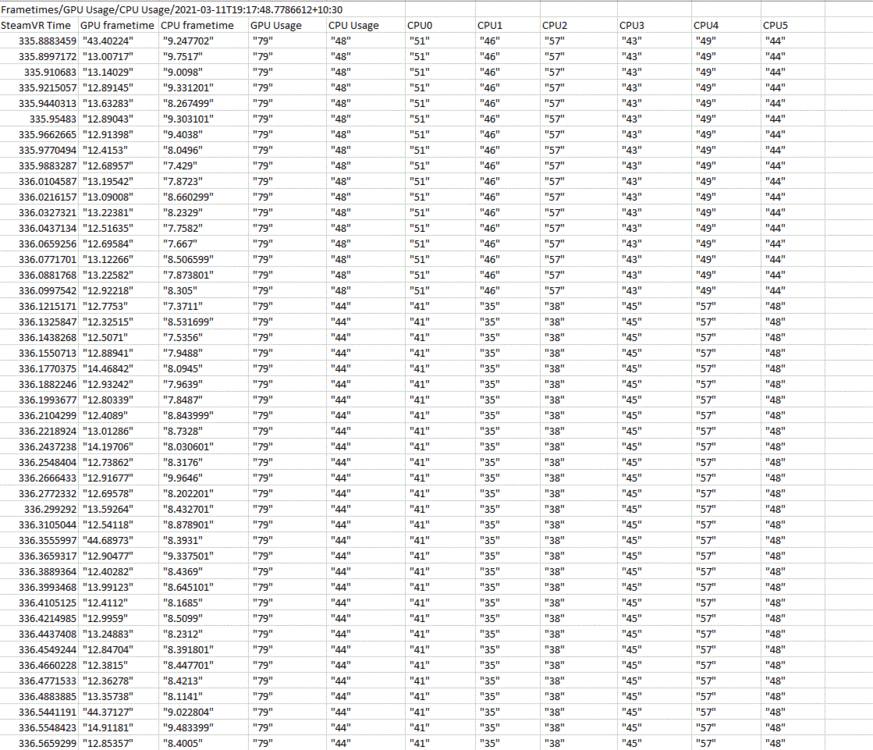-
Posts
293 -
Joined
-
Last visited
Content Type
Profiles
Forums
Events
Everything posted by Avalanche110
-

Nominate parking spot in mission editor for SC
Avalanche110 replied to Avalanche110's topic in Wish List
This is extremely useful. Thanks! -

Nominate parking spot in mission editor for SC
Avalanche110 replied to Avalanche110's topic in Wish List
I think one of my biggest "concerns" is that the standard cold start parking spot is in the middle of the deck. At least in multiplayer you spawn on an elevator. It makes it difficult to build missions when you don't know where you, or the AI are going to spawn. It takes a lot of trial and error placing static objects to block parking spots. Being able to nominate a parking spot would simplify this a great deal. (IMO) Once its set up, it really is an amazing module. -
I'm glad you found it useful. I have learned a lot from this thread and look forward to doing more testing with a new CPU. All the best.
-
Yes, I am quite familiar with that. I found using Pitool S.S was extremely taxing. There was noticeable a improvement in stuttering when rendering the same number of pixels using SteamVR. I have attached a P.D Calculator so you can work out how many pixels your actually rendering. PDSSCalc.zip
-
I have just pre-ordered an 11900K, along with a all the bits for a new build. I will do another set of comparison tests to objectively quantify what improvement it makes. If anyone has suggestions on a test scenario, or a particular mission, or a particular module, please let me know. That's if I actually get it this year.....
-
I imagine FFR would be very useful in a situation where the GPU was the limiting factor, AND their was CPU overhead. But From what I could tell, It made it look and run worse. @frenzon reported that it made a huge improvement running his 8kx. This technology is not supported by older GPU's. The FFR options were not available in Pitool when the 1080ti was installed. I had terrain shadows set to flat for along time. It wasn't until I changed P.D settings that went to Default shadows. I recently started using this Shadow mod I found in SpeedOfHeats Thread. give it ago and see what you think.
-
I did a little more testing on FFR. I got FFR working with the shader mod without significant artefacts. Unfortunately it increased CPU frame times by around 5ms on average and decreased frame rates. GPU utilization was significantly lower with FFR, this would definitely be an advantage for a lot of people. For me however, I have opted to stick with FFR off.
-
In most circumstances, Tacview will use very little CPU overhead. I have used it for years without issue. However..... Tacview's CPU usage Scales with the size of the mission. the more units and munitions that tacview needs to track, the more CPU overhead it will consume. I Run a dedicated server with a mission running hundreds of lua scripts, and hundreds of units. The Server log indicated that :GetWorldObject ( just 1 algorithm Tacview requires) was using 7% of CPU. this was running on both the Server and the OB install so tacview's impact was significant. Uninstalling Tacview improved CPU frame times by a noticeable margin. I'm not suggesting that anyone else immediately uninstall it, Just be aware that it can have a significant performance impact in some circumstances. As a reference the average Tacview file that i would review after running the server would be between 15Mb & 18Mb
-
Can I ask what GPU you upgraded from? Did you notice a significant performance increase going to a 3090. I have found the 3090 to be a night and day when compared to the 1080ti
-
Yes!....... and No! There are so many DCS settings that provide little to no visual improvement, but are a massive strain on your system. I ran another test in the Gazelle to see how far I could push the settings while maintaining a smooth 45FPS. PD set to 1.0 SteamVR resolution to 200% I noticed only a slight improvement in visual quality over my original settings. Terrain textures set to high uses 20Gb of VRAM, thats double what a 3080 has, Provides 0 improvement in visual quality ( in my opinion ) MSAA at 4X is slightly better, but not worth the FPS hit. SSAA and SSLR, didnt notice any difference with them on, other than massive GPU load. Anisotropic filtering at 16X: you have to look pretty hard to notice a difference. Visible Range is the real Killer! I use Medium for helicopters, high for fixed wing. GPU utilization was very inconsistent. 96% in forested areas, and 64% in open areas. I will definitely be sticking with my original settings. When I was on the 1080ti, I would prioritise Good visual quality at angels 30 and put up with lag and stutter when taxiing to the runway. Upgrading to the 3090 provides the eye candy at altitude, and has dramatically improved the experience on the ground.
-
I have DCS:Stable installed without the shader mod. I tried FFR on the Pimax and didn't notice any undesirable distortions. It would be interesting to see what delivers the biggest performance increase. FFR or the shader mod.
-
Can I ask if your using the Vr Shader mod? if so what did you set the MaskSize to for the Pimax ( I have it set to 0.675) I suspect that FFR does not play well with the rest of the optimizations I am using. It might be worth looking into. Also, How do you find the 8KX? I am considering upgrading from the 5k+
-
Fixed Foveated Rendering is a way of reducing a VR applications GPU load. It achieves this by rendering the outer portions of your FOV at a lower resolution. I found that It created some really undesirable distortions and artefact's in the display. It also increased the CPU overhead, so their was no real advantage in using it at all. I suspect that It might work better with Eye tracking. But in DCS for now. Its not desirable.
-
I will Direct you to SpeedOfHeats thread where he explains his optimizations and settings in Depth. I happened to stumble across it yesterday and found it Really useful.
-
The decrease in GPU frametimes make it significantly smoother. I kept the settings the same in the test so it would be an accurate comparison between the GPU’s
-
No problem. 1). When testing originally, I was using OBS to record the flight. that was quite taxing on the CPU. 2). Tacview, was a MASSIVE burden. as much as i like tacview, I uninstalled it. 3). Mirrors were using 0.6% of the CPU even though the gazelle does not have mirrors, disabled it in DCS settings. 4). Disabled "Fixed foveated rendering" in Pitool - this made a massive difference to CPU frame times and increased GPU load. If you refer back to the original post in this thread, you can see the system specs and all the optimizations I have used. All testing was done on a mission loaded to a dedicated server running on the same machine, this does wonders for smoothing out DCS in VR. DCS SETTINGS.bmp
-
Having removed some pretty significant CPU bottle necks. I decided it would only be fair to do another comparison between the 1080ti and 3090. Test Scenario: Same mission, loaded onto a dedicated server running on the same PC I use for VR. Flying a Gazelle at treetop level from a Fob in Karsi, through mountain valleys to a target near Allepo I decided to be kinder to the 1080ti this time around and set the time of day to 8:30 as opposed to 7:30 (dawn) in the original test. Test Methodology: FPSVR Data logging utility to record GPU & CPU frame times. This method is far less taxing on the CPU than recording the flight in OBS. Removing the CPU bottle neck really helped the 1080 achieve a smooth and consistent frame rate, where as it previously jumped around a lot more. I was instantly reminded of why I decided I needed a new graphics card, average GPU frame times during cold start were in the mid 20's and It was barely making 40FPS. The GPU utilization was pinned at 98% for the entire flight, It did manage to sneak into the 50fps range once I had reached the open planes behind Karsi. The lowest GPU frame time recorded was 17.95ms. Lowest FPS recorded was 25FPS, highest was 53FPS. AVERAGE GPU FRAME TIME = 22.62ms AVERAGE CPU FRAME TIME = 10.20ms AVERAGE FPS = 43.7 Swapped out the 1080ti and reinstalled the 3090. Repeated the test using the exact same settings, drivers, resolution etc. Was blown away at the improvement (again) average GPU frame times approximately 10ms faster. Surprisingly, I did notice marginally better CPU frame times. This may have to do with the higher Vram on the 3090, or the drivers are running more efficiently with the newer Graphics card. There were several occasions when FPS was locked at 90 which is the Maximum Hz the Pimax can run at with a Large FOV setting. AVERAGE GPU FRAME TIME = 11.38ms (improvement: 98.76%) AVERAGE CPU FRAME TIME = 9.88ms (improvement: 3.23%) AVERAGE FPS = 76.0 (improvement: 73.91%) I don't think I could possibly make this test more accurate or the evidence any more empirical. if any one has any suggestions, please let me know. 1080ti FPSVR log 3090 FPSVR Log
-
I Left it with a P.D of 0.5 for consistency when trying out various other settings. The settings I had used previously was P.D at 1 and resolution to 1.25 in Pitool. I did notice an improvement in stuttering when I switched to using SteamVR to set Resolution. Pitool is a notoriously buggy piece of software. Despite having disabled Tacview in game, It was still running on the server. The server logs indicated that :GetWorldObjects was using 7% CPU. I disabled Tacview and turned mirrors off in DCS settings and now I have an average FPS in the mid 70's in the same scenario as above. I think I should fire up the 1080ti again for another side by side comparison.
-
I spent the day playing with Various settings to dial in the best results. Using the PDSS calculator, I worked out that a P.D of 1.0 and Steam Resolution of 125% is the Same number of Pixels as P.D 0.5 - Steam Resolution at 496% Tested both and found no difference either way. Disabled all antialiasing, really didn't notice a significant boost in GPU or CPU frame times, So opted to keep it. I Disabled "fixed Foveated Rendering" in PiTool - this was increasing CPU frame times significantly, While Decreasing GPU load. It would seem that OBS was bottle necking my CPU, so I stopped using it. I also opted to disable Tacview. I conducted the test mission in the gazelle once again. All DCS settings remain unchanged. DCS P.D: 0.5 SteamVR Resolution per eye: (496%) DCS Dedicated server - Syria Mission Start time: 08:30 1 minute = 68FPS – GPU FRAMETIME = 16.7ms CPU FRAMETIME = 10.0ms – GPU = 93% (improvement = +5FPS) + 7.93% 5 minute = 62FPS – GPU FRAMETIME = 15.5ms CPU FRAMETIME = 13.4ms – GPU = 91% (improvement = +9FPS) + 16.98% 10 minute = 66FPS – GPU FRAMETIME = 13.8ms CPU FRAMETIME = 13.5ms – GPU = 93% (improvement = +11FPS) + 20.00% 15 minute = 64FPS – GPU FRAMETIME = 16.0ms CPU FRAMETIME = 13.1ms – GPU = 88% (improvement = +15FPS) + 30.61% 20 minute = 70FPS – GPU FRAMETIME = 14.0ms CPU FRAMETIME = 11.1ms – GPU = 85% (improvement = +18FPS) + 34.61% 25 minute = 74FPS – GPU FRAMETIME = 13.5ms CPU FRAMETIME = 10.2ms – GPU = 89% (improvement = +15FPS) + 25.42% 30 minute = 70FPS – GPU FRAMETIME = 15.3ms CPU FRAMETIME = 10.4ms – GPU = 91% (improvement = +14FPS) + 25.00% 35 minute = 68FPS – GPU FRAMETIME = 16.8ms CPU FRAMETIME = 10.5ms – GPU = 94% (improvement = +13FPS) + 24.00% 40 minute = 68FPS – GPU FRAMETIME = 15.6ms CPU FRAMETIME = 11.2ms – GPU = 91% (improvement = +13FPS) + 23.00% Conclusion: Upgrading from a 1080ti to a 3090 has increased performance by an average of 28.7% ( in an apples for apples test scenario ) As the test above indicates, The 3090 is capable of an average 67.7 FPS, flying a helicopter at treetop level In Syria with MSAA and antialiasing turned on. Ultimately, For every 1% increase that a 3090 provides, It costs $92.39 (USD)
-
Just to clarify, the inconsistency in frame rates for the first 15 minutes is largely caused by the time of day. this is where the DCS graphics engine is the issue, as opposed to resolution or Antialiasing. I chose to use this as the test because the 1080ti could not cope with the work load and it became unflyable. The 3090 had a 100% improvement, doubling FPS in this scenario. Making something that was unflyable a minor inconvenience. I Re-Ran the the test using the same settings, Just changed the time of day from 07:30 to 08:30 and got a 20% increase in FPS for the first 20min. 3090: Pixel density 0.5 – Resolution per eye – 500% Time of day = 07:30 1 minute = 61FPS – GPU FRAMETIME = 15.0ms CPU FRAMETIME = 15.9ms – GPU = 87% 5 minute = 53FPS – GPU FRAMETIME = 15.9.2ms CPU FRAMETIME = 18.1ms – GPU = 81% 10 minute = 49FPS – GPU FRAMETIME = 20.0ms CPU FRAMETIME = 29.8ms – GPU = 90% 15 minute = 50FPS – GPU FRAMETIME = 20.9ms CPU FRAMETIME = 25.9ms – GPU = 91% 20 minute = 48FPS – GPU FRAMETIME = 20.1ms CPU FRAMETIME = 20.1ms – GPU = 90% 3090 Pixel density 0.5 – Resolution per eye – 500% Time of day = 08:30 1 minute = 63FPS – GPU FRAMETIME = 14.4ms CPU FRAMETIME = 16.4ms – GPU = 83% (improvement = +2FPS) + 3.27% 5 minute = 52FPS – GPU FRAMETIME = 16.5ms CPU FRAMETIME = 16.9ms – GPU = 75% (improvement = -1FPS) – 1.8% 10 minute = 55FPS – GPU FRAMETIME = 17.1ms CPU FRAMETIME = 16.9ms – GPU = 89% (improvement = +5FPS) = +12.24% 15 minute = 49FPS – GPU FRAMETIME = 18.3ms CPU FRAMETIME = 18.6ms – GPU = 70% (improvement = - 1FPS) - 2.00% 20 minute = 52FPS – GPU FRAMETIME = 15.0ms CPU FRAMETIME = 17.6ms – GPU = 66% (improvement = +4FPS) + 8.33% Average percentage increase = +20.04% You can see that the GPU utilization was significantly lower in the second test.
-
What your saying does make sense. You posted a link to a "PDSS calculator" in another thread. I'm not sure i am using it correctly as I don't know what value to add For SS PD =0.5 - Resolution 5728 x 4708 - SS= 1 ( 67418 Pixels ) vs PD =1.0 - Resolution 3176 x 2612 - SS= 1 ( 82957 Pixels ) Anyway, I took your advice and dropped Resolution to 150% and increased DCS P.D to 1.0, I got a 7.67% decrease in average FPS. 3090: Pixel density 0.5 – Resolution per eye – 500% 1 minute = 61FPS – GPU FRAMETIME = 15.0ms CPU FRAMETIME = 15.9ms – GPU = 87% 5 minute = 53FPS – GPU FRAMETIME = 15.9.2ms CPU FRAMETIME = 18.1ms – GPU = 81% 10 minute = 49FPS – GPU FRAMETIME = 20.0ms CPU FRAMETIME = 29.8ms – GPU = 90% 15 minute = 50FPS – GPU FRAMETIME = 20.9ms CPU FRAMETIME = 25.9ms – GPU = 91% 20 minute = 48FPS – GPU FRAMETIME = 20.1ms CPU FRAMETIME = 20.1ms – GPU = 90% 25 minute = 59FPS – GPU FRAMETIME = 13.4ms CPU FRAMETIME = 16.0ms – GPU = 70% 30 minute = 56FPS – GPU FRAMETIME = 15.0ms CPU FRAMETIME = 17.2ms – GPU = 62% 35 minute = 50FPS – GPU FRAMETIME = 15.3ms CPU FRAMETIME = 19.1ms – GPU = 60% 40 minute = 55FPS – GPU FRAMETIME = 16.1.4ms CPU FRAMETIME = 17.6ms– GPU = 82% 45 minute = 51FPS – GPU FRAMETIME = 15.5ms CPU FRAMETIME = 18.3ms – GPU = 71% 3090 Pixel density 1.0 – Resolution per eye – 150% 1 minute = 61FPS – GPU FRAMETIME = 14.6ms CPU FRAMETIME = 15.2ms – GPU = 91% (improvement = 0FPS) + 0% 5 minute = 50FPS – GPU FRAMETIME = 16.0ms CPU FRAMETIME = 18.8ms – GPU = 82% (improvement = -3FPS) – 5.6% 10 minute = 44FPS – GPU FRAMETIME = 21.3ms CPU FRAMETIME = 25.3ms – GPU = 94% (improvement = -5FPS) - 10.20% 15 minute = 46FPS – GPU FRAMETIME = 23.2ms CPU FRAMETIME = 25.4ms – GPU = 88% (improvement = -4FPS) - 8.00% 20 minute = 50FPS – GPU FRAMETIME = 18.8ms CPU FRAMETIME = 18.0ms – GPU = 82% (improvement = +2FPS) + 4.16% 25 minute = 48FPS – GPU FRAMETIME = 18.1ms CPU FRAMETIME = 19.2ms – GPU = 72% (improvement = -6FPS) - 10.90% 30 minute = 49FPS – GPU FRAMETIME = 16.0ms CPU FRAMETIME = 19.2ms – GPU = 67% (improvement = -11FPS) - 19.64% 35 minute = 48FPS – GPU FRAMETIME = 18.6ms CPU FRAMETIME = 20.1ms – GPU = 71% (improvement = -2FPS) = -4.00% 40 minute = 43FPS – GPU FRAMETIME = 18.2ms CPU FRAMETIME = 22.1ms – GPU = 64% (improvement = -12FPS) – 21.81% 45 minute = 52FPS – GPU FRAMETIME = 17.8ms CPU FRAMETIME = 18.3ms – GPU = 71% (improvement = +1FPS) + 1.96% Average percentage decrease = -7.40% decrease in performance Average FPS Decrease = -4.1FPS -7.67%
-
Lucas s/ Wolta posted this about a week ago. I tried it and was surprised by the results. However, what Speed of heat mentioned above does make sense also. Their may be something to it, their may not. I have just tried another test with DCS pixel density at 1.0 and SteamVR Resolution at 150% See results Below: VR performance.bmp
-
In the First test, Its the time of day. Just as the sun rises DCS tries to compute a ridiculous amount of shadows. It puts a huge strain on Both the CPU and GPU. In the Second test, the time of day is factor for the first 15min. once airborne FPS improves significantly. My 1080ti never had a problem at altitude, but taxiing around runways was becoming a problem.
-
Test Scenario 2: Loaded the same mission to a dedicated Server. This time chose a F/A-18C taking off from Ramat David for a A2A Cap mission. Test mission was cut shorter than I would have liked as I ate a R2-7ER in the second mission. 1080ti 0 minute = 31FPS – GPU FRAMETIME = 30.6ms CPU FRAMETIME = 20.3ms 5 minute = 34FPS – GPU FRAMETIME = 29.3ms CPU FRAMETIME = 20.7ms 10 minute = 11FPS – GPU FRAMETIME = 87.3ms CPU FRAMETIME = 18.4ms 15 minute = 35FPS – GPU FRAMETIME = 18.0ms CPU FRAMETIME = 11.4ms 20 minute = 46FPS – GPU FRAMETIME = 16.7ms CPU FRAMETIME = 10.2ms 25 minute = 55FPS – GPU FRAMETIME = 18.2ms CPU FRAMETIME = 11.1ms 30 minute = 58FPS – GPU FRAMETIME = 16.8ms CPU FRAMETIME = 10.9ms 35 minute = 51FPS – GPU FRAMETIME = 19.6ms CPU FRAMETIME = 13.2ms 3090 0 minute = 46FPS – GPU FRAMETIME = 18.8ms CPU FRAMETIME = 25.0ms – GPU = 77% (improvement = 15FPS) + 48.38% 5 minute = 39FPS – GPU FRAMETIME = 20.0ms CPU FRAMETIME = 26.1ms – GPU = 74% (improvement = 5FPS) + 14.70% 10 minute = 22FPS – GPU FRAMETIME = 47.7ms CPU FRAMETIME = 46.8ms – GPU = 92% (improvement = 11FPS) + 100.00% 15 minute = 64FPS – GPU FRAMETIME = 11.3ms CPU FRAMETIME = 14.5ms – GPU = 68% (improvement = 29FPS) + 82.85% 20 minute = 69FPS – GPU FRAMETIME = 10.8ms CPU FRAMETIME = 14.6ms – GPU = 64% (improvement = 23FPS) + 50.00% 25 minute = 61FPS – GPU FRAMETIME = 13.5ms CPU FRAMETIME = 15.4ms – GPU = 64% (improvement = 6FPS) + 10.90% 30 minute = 64FPS – GPU FRAMETIME = 18.2ms CPU FRAMETIME = 16.2ms – GPU = 67% (improvement = 6FPS) + 10.3% 35 minute = 73FPS – GPU FRAMETIME = 12.8ms CPU FRAMETIME = 12.9ms – GPU = 66% (improvement = 22FPS) = 43.13% Average percentage increase = 51.08% increase in performance (when GPU is the bottle neck) Average FPS increase = 14.6FPS 31.33%
-
I had only been using this setting for 1 week, It was based on a post from Lucas S. Walter on Youtube. He did it as a joke, and found improved performance. I tried it and was also surprised to find a noticeable reduction in stuttering. Like most of us. I have spent days agonising over optimisation and VR performance. More comparisons to Come........







